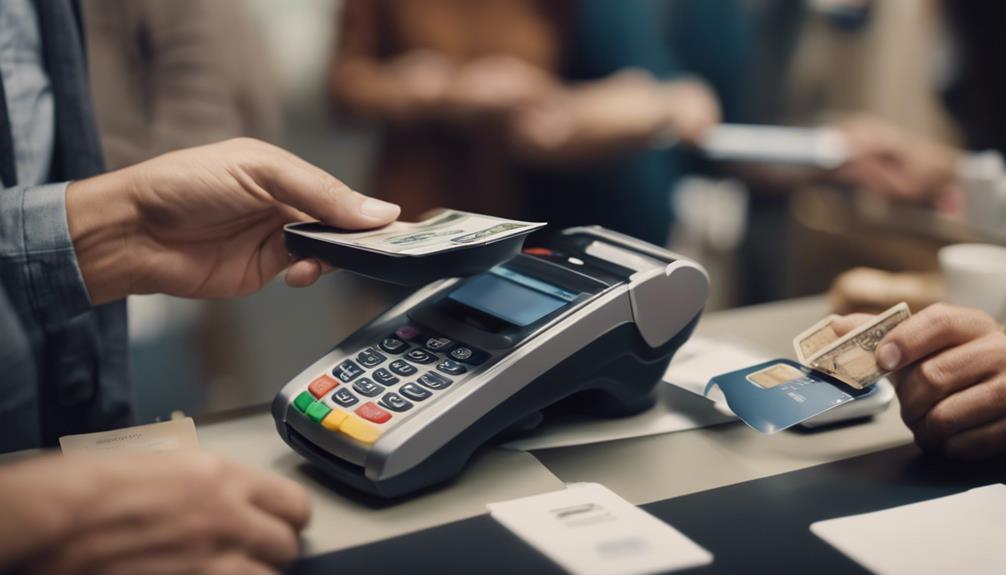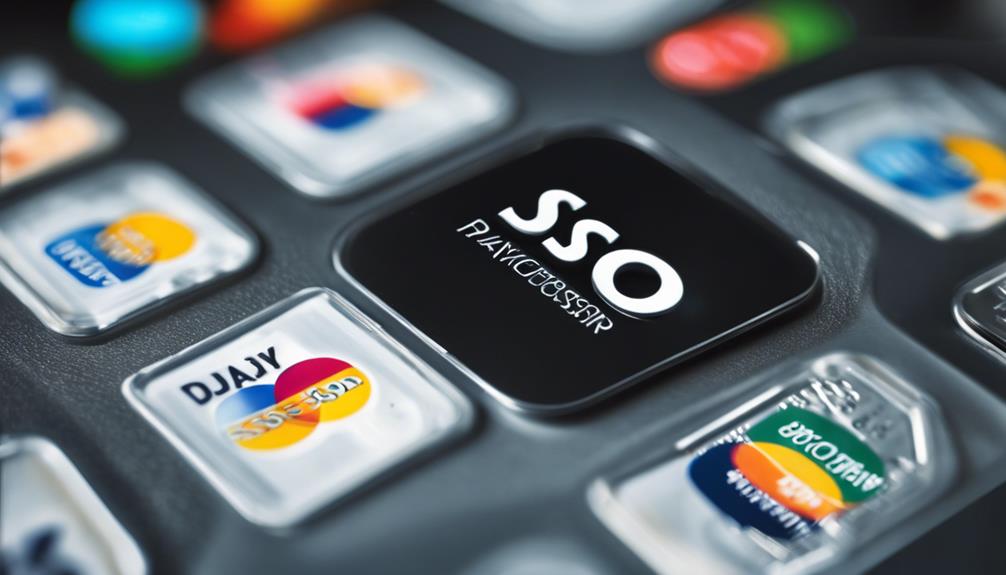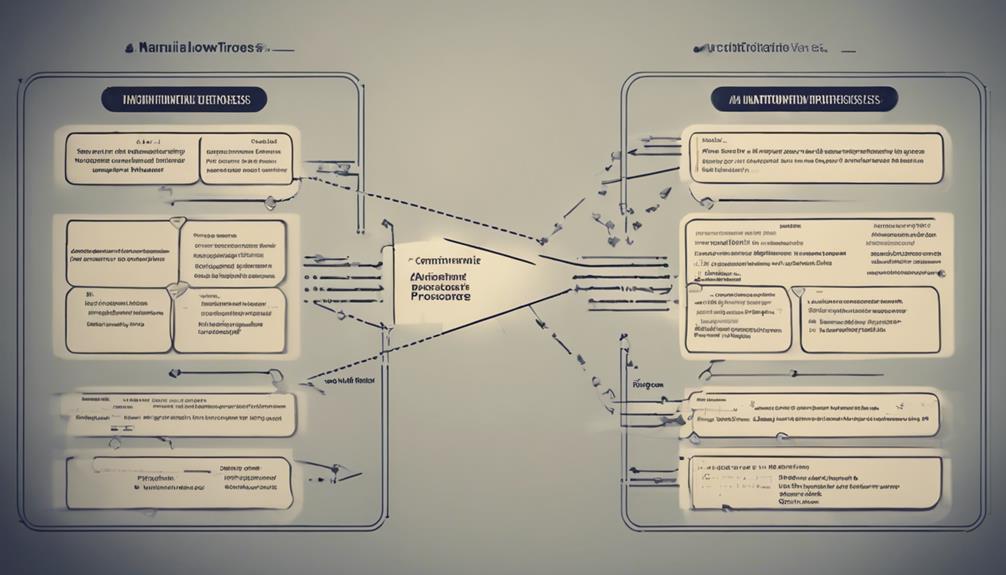Credit Card Processing & ISOs
Understanding ISO Payment Processing
Honing your knowledge on ISO payment processing holds the key to unlocking innovative solutions for your business – delve in to discover more!
Understanding ISO payment processing is crucial for businesses looking to improve payment efficiency and broaden customer reach. ISOs act as intermediaries between merchants and acquiring banks, facilitating seamless transactions. They offer diverse services, including online gateways and analytics tools, to streamline payment processes. ISOs generate revenue through sales and transaction fees, aiding businesses in expanding their clientele. By comprehending the roles of ISOs in payment processing, you reveal opportunities for enhanced operational effectiveness and customer service. Further exploration into ISO partnerships and operational insights can provide valuable knowledge for optimizing payment solutions. Explore to uncover the depth of ISO payment processing intricacies.
Key Takeaways
- ISOs act as intermediaries between merchants and acquiring banks.
- They offer cost savings, enhanced security, and streamlined payment processes.
- ISOs possess technologies for tailored solutions and competitive pricing.
- Sales agents are crucial for expanding reach and increasing revenue.
- Partnering with acquiring banks ensures efficient transaction processing and industry connections.
What Is an ISO Payment Processor?

An ISO payment processor is an essential partner for businesses seeking to accept credit card payments efficiently and securely. These ISOs, or Independent Sales Organizations, work in conjunction with acquiring banks to provide merchant services, facilitating the processing of credit card payments.
By partnering with registered ISO payment processors, businesses gain access to a range of payment processing solutions, including online gateways, hardware/software sales, and analytics programs. ISO payment processors earn revenue by selling hardware/software and taking a percentage of transaction revenues, making them important players in the world of credit card processing.
Their official partnerships with banks make sure that businesses can securely accept credit card payments, ultimately helping them expand their customer base and streamline their payment processes. ISO payment processors act as intermediaries between businesses and acquiring banks, offering essential services that enable businesses to access the world of credit card transactions with ease and efficiency.
ISO Vs. Acquirer: Key Differences

When comparing ISOs to acquirers, it's important to understand the key differences between the two.
ISOs define their roles in reselling payment processing services, while acquirers handle the technology for credit card transactions.
These distinctions play a significant role in how each entity functions within the payment processing ecosystem.
ISO Role Definition
In the domain of payment processing, distinguishing between ISOs and acquirers is essential for understanding their respective roles and contributions.
- ISOs focus on selling and distributing payment processing services to merchants.
- Acquirers are the banks that handle the processing operations of debit/credit card transactions.
- ISOs can work with multiple acquiring banks, providing a broader range of products.
- Non-bank ISOs often excel in offering cutting-edge services and exceptional customer support.
Understanding these distinctions is vital in grasping how ISOs and acquirers collaborate to deliver efficient and reliable payment processing solutions to businesses.
Acquirer Responsibilities Overview
Acquirers play a pivotal role in the processing of card transactions, managing the technology and communication necessary for transaction approval with financial institutions. They receive transaction data from merchants and focus on transaction processing operations. Unlike ISOs that resell payment processing services, acquirers are directly responsible for handling the technical and operational aspects of payment processing.
Acquirers collaborate with financial institutions to guarantee seamless transaction flow. They play an essential role in making sure that merchants receive timely approvals for their transactions. Additionally, acquirers often provide essential customer support to merchants, addressing any issues that may arise during the payment processing. This support is instrumental in maintaining smooth payment operations for businesses.
Distinctions Between ISOs
Wondering how ISOs differ from Acquirers in the domain of payment processing responsibilities? Here are some key distinctions worth noting:
- ISOs: Resell payment processing services from acquiring banks, offering various merchant services.
- Acquirers: Focus on processing transactions and managing approvals, while ISOs handle sales, distribution, and value-added services.
- ISOs: Can work with multiple acquirers, providing businesses with a broader range of payment solutions.
- ISOs: Non-bank ISOs are known for innovative services and exceptional customer support, while bank ISOs often concentrate on consolidating financial services.
Benefits of Working With ISOS

When working with ISOs, you can benefit from cost savings opportunities, enhanced payment security, and streamlined payment processes.
Cost Savings Opportunities
Working with ISOs can provide businesses with significant cost-saving opportunities in payment processing services. Here are some ways ISOs can help you save money:
- Competitive Pricing Negotiations: ISOs can negotiate competitive pricing for payment processing services, ensuring you get the best rates available.
- Access to a Wider Range of Payment Solutions: ISOs offer businesses access to diverse payment solutions at potentially lower costs compared to direct merchant service provider relationships.
- Cost-Effective Solutions: By partnering with ISOs, businesses can benefit from cost-effective payment processing solutions tailored to their specific needs.
- Increased Profit Margins: ISOs help businesses cut costs, save on transaction fees, and ultimately boost profit margins.
Enhanced Payment Security
Partnering with ISOs for payment processing services can provide your business with enhanced payment security measures to safeguard transactions and protect sensitive customer data. ISOs guarantee compliance with industry regulations, implement secure payment processing systems, and offer expertise in payment security measures.
By working with ISOs, businesses can reduce fraud risks and enhance data protection during transactions. ISOs facilitate secure payment processing through encrypted transactions and data protection protocols, helping you maintain a secure payment environment.
This partnership allows businesses to benefit from the latest security technologies and practices, ensuring that your payment processes remain secure and compliant. Trusting ISOs with your payment security needs can give you peace of mind and help build trust with your customers.
Streamlined Payment Processes
By collaborating with ISOs, businesses can experience a significant boost in efficiency through streamlined payment processes. ISOs streamline payment processing tasks, offering quick merchant account setup and dedicated customer support.
Partnering with multiple acquirers, ISOs provide flexibility for businesses to accept various payment options. Additionally, working with ISOs allows businesses to negotiate competitive pricing for payment processing services, ensuring cost-effectiveness.
ISOs play an essential role in ensuring secure and compliant payment processing, reducing fraud risks and safeguarding customer information. This strategic partnership not only simplifies payment processes but also enhances overall operational effectiveness, making ISOs a valuable asset for businesses seeking optimized payment solutions.
Evaluating ISO Partnerships

Consider evaluating ISO partnerships based on the hardware solutions they offer to meet your specific business needs. When examining potential ISO partnerships, look for providers that not only offer a range of hardware solutions but also make certain that these solutions are tailored to your industry requirements.
Additionally, consider the flexibility and sophistication of the software solutions provided by ISOs. It's important to align the processing volume and associated fees with your business's needs to optimize cost-effectiveness.
Moreover, seek out ISO partners that integrate loyalty programs into their payment reports, as this can add significant value to your business. However, be cautious of hidden fees and long contract lengths when evaluating ISO partnerships.
ISO Operations Overview

ISOs operate as independent sales organizations that collaborate with acquiring member banks to deliver a range of merchant services, encompassing credit card processing, online gateways, hardware, software, and analytics programs.
When delving into the operations of ISOs, consider the following key points:
- Role of ISOs: ISOs act as intermediaries between merchants and acquiring banks, facilitating payment processing services.
- Technological Capabilities: They possess their own technologies to support payment processing, offering tailored solutions to merchants.
- Sales Agents: ISOs can recruit and manage sales agents who promote their services to merchants, expanding their reach in the market.
- Relationship with Acquiring Banks: ISOs partner with acquiring banks to access the necessary infrastructure for processing transactions efficiently.
These aspects collectively highlight the pivotal role ISOs play in the merchant services industry, leveraging their expertise, technology, and networks to streamline payment processing for businesses and enhance the overall customer experience.
ISOS Vs. Payment Processors

When comparing ISOs to payment processors, a key distinction lies in their respective focuses and roles within the merchant services industry. ISOs, or independent sales organizations, collaborate with acquiring banks to offer a range of merchant services. They prioritize personalized customer service and support for businesses seeking payment solutions.
On the other hand, payment processors concentrate on the technical aspects of transaction processing, ensuring seamless payment operations.
ISOs generate revenue through various sources like merchant account setup fees, transaction percentages, monthly service fees, and equipment sales or leasing. Acting as resellers of payment processors' services, ISOs work in tandem with these entities to deliver efficient payment processing solutions to merchants. While Visa uses the term ISO, Mastercard refers to them as MSPs, though their functions align closely in practice within the industry.
In essence, ISOs focus on customer service and establishing merchant relationships, while payment processors excel in the technical execution of payment transactions, all in collaboration with acquiring banks to facilitate merchant services.
Potential Drawbacks of ISO Partnerships

Partnering with an ISO for payment processing services may introduce several potential drawbacks that businesses should carefully consider. When entering into ISO partnerships, keep in mind the following key points:
- Cost Increases: Businesses may face potential cost hikes due to commissions and fees associated with ISO partnerships, impacting overall profitability.
- Response Times: Longer response times for issue resolution may occur with ISO partnerships compared to direct relationships with payment processors, affecting operational efficiency.
- Customization Challenges: Standard ISO offerings might lack the necessary customization and flexibility to meet specific operational needs, potentially hindering business performance.
- Complex Contracts: ISO partnerships may involve intricate contractual agreements that limit scalability and adaptability in the long term, requiring careful consideration before committing.
Carefully evaluating these aspects will help businesses make informed decisions regarding ISO partnerships and ensure that the chosen payment processing solution aligns with their operational requirements.
Starting an ISO: Key Considerations

To successfully launch an ISO, assembling a leadership team with extensive experience in the payment industry is paramount. Having individuals who can provide guidance on industry understanding, management, and strategy is essential for the success of your ISO.
These leaders will also play a key role in assisting you in setting up operations and sales processes, which are essential for a newly established ISO to thrive in the competitive market.
Shifting customers to the Clearly Payments platform can streamline operations for your ISO, making the onboarding process more efficient. If you require more information on how to start an ISO and navigate the intricacies of the payment industry, you can reach out to kalle@clearlypayments.com for further assistance.
Frequently Asked Questions
How Does an ISO Work in Payments?
In payments, an ISO acts as a middleman between merchants and acquiring banks. They facilitate payment processing by setting up merchant accounts, charging transaction fees, and offering equipment sales or leases. ISOs guarantee seamless transactions, provide personalized solutions, support, risk management, and compliance with regulations.
What Is an ISO in Payment Processing?
An ISO in payment processing acts as a middleman between merchants and acquiring banks, facilitating credit card transactions. They offer merchant services such as processing, gateways, and analytics tools. ISOs earn revenue by selling solutions and taking a cut of transaction fees.
Their pivotal role enables businesses to accept card payments efficiently. ISOs, with official bank partnerships, set up and manage merchant accounts, providing essential support for seamless payment processing.
What Is the ISO Model of Payment?
The ISO model of payment revolves around independent sales organizations partnering with acquiring banks to offer merchant services. ISOs have their own technologies and sales agents, setting processing rates and earning revenue from transaction percentages.
They provide essential services like credit card processing, online gateways, hardware, software, and analytics programs. ISOs are pivotal intermediaries in the payment ecosystem, bridging the gap between merchants and consumers with a variety of payment solutions.
How Do You Explain Payment Processing?
Payment processing involves authorizing, capturing, and settling electronic transactions. Card details are verified, funds checked, and money securely transferred from customer to merchant. Processors facilitate information flow between merchants, banks, and card networks for successful transactions.
Encryption, PCI DSS standards, and regulatory compliance protect cardholder data. Businesses rely on payment processing to accept various payments and streamline financial transactions with customers.
Conclusion
To sum up, understanding ISO payment processing is essential for businesses looking to expand their payment options. Working with an ISO can offer numerous benefits, such as increased flexibility and competitive pricing. However, it's important to carefully evaluate potential ISO partnerships and consider the potential drawbacks.
Starting an ISO requires careful consideration of various factors. Overall, partnering with an ISO can be a game-changer for your business, offering a wide range of advantages that can help drive growth and success.
Credit Card Processing & ISOs
Understanding the Dynamics of Chargebacks and How to Contest Them
Baffled by chargebacks? Unravel the complexities and learn how to effectively contest them for business success.

To understand chargebacks, grasp various reasons like criminal fraud or friendly fraud. Respond promptly with evidence to contest them effectively, as issuing banks have the final say. Analyzing transactions and customer interactions aids in prevention strategies. Implement fraud filters, address verification, and clear communication to reduce risks. Monitoring chargeback data is important for business efficiency. Contesting chargebacks involves understanding reason codes, providing evidence, and using management tools. Proactive management minimizes revenue loss and boosts fraud detection. Businesses can suffer operational costs and reputational damage from chargebacks. Best practices include secure protocols, clear policies, excellent service, and staff education. Learn more about managing chargeback dynamics for successful dispute resolution.
Key Takeaways
- Know reason codes for effective dispute resolution.
- Submit evidence promptly during investigations.
- Issuing banks make final decisions on chargebacks.
- Implement fraud filters for real-time detection.
- Utilize chargeback management tools for efficient resolution.
Recognizing Chargeback Dynamics

To navigate the intricacies of chargeback dynamics effectively, you must grasp the various reasons that lead to these transaction reversals. Understanding the reason codes associated with chargebacks is essential for merchants in order to effectively dispute them.
When a chargeback occurs, prompt response is key. Merchants should promptly respond to chargeback notices to contest the dispute. This quick action can help in providing the necessary information during the investigation process.
The investigation of chargebacks involves a complex process that includes submitting evidence and ultimately culminates in a decision made by the issuing banks. As a merchant, it's vital to be proactive and thorough in your response to chargebacks.
Being aware of the various stages in the chargeback process and the role of issuing banks can help you navigate this challenging aspect of payment disputes more effectively. By understanding the dynamics involved in chargebacks, you can better position yourself to contest them successfully.
Understanding Chargeback Reasons

Understanding the reasons behind chargebacks is essential for merchants to effectively dispute and prevent these transaction reversals. Chargebacks can occur due to various reasons, including criminal fraud, merchant error, and friendly fraud. Here is a breakdown of these chargeback reasons:
| Reason | Description |
|---|---|
| Criminal Fraud | Unauthorized purchases made with stolen card information by malicious actors. |
| Merchant Error | Mistakes in processing transactions or fulfilling orders by the merchant leading to chargebacks. |
| Friendly Fraud | Intentional or unintentional misuse of the chargeback process by cardholders, causing transaction disputes. |
Analyzing Transaction Records

When analyzing transaction records, you should focus on:
- Reviewing purchase details
- Identifying fraud patterns
- Gathering evidence promptly
By scrutinizing these records, you can pinpoint potential issues that may lead to chargebacks and take proactive measures to address them.
Utilizing technology to automatically flag suspicious transactions can streamline this process and enhance your ability to prevent and mitigate chargebacks effectively.
Reviewing Purchase Details
Analyzing transaction records by reviewing purchase details plays a critical role in identifying patterns and discrepancies essential for effective chargeback dispute resolution. By examining customer information, purchase details, and matching them with chargeback reasons and sales data, merchants can uncover inconsistencies that may assist in resolving disputes.
This thorough review not only aids in dispute resolution but also helps in developing prevention strategies to reduce future chargebacks. Additionally, a detailed analysis of purchase details can reveal areas for improvement in customer service, product delivery, and communication processes.
Understanding the nuances within transaction records is key to mitigating chargeback risks and enhancing overall business operations.
Identifying Fraud Patterns
By closely examining transaction records, you can swiftly pinpoint fraud patterns and potential chargeback triggers. When analyzing transaction data for fraud patterns, consider the following:
- Monitoring customer interactions through transaction records reveals common fraud indicators.
- Detecting unusual purchase behavior or recurring disputes in transactions signals potential fraud.
- Matching chargeback reasons with sales data aids in pinpointing specific fraud patterns for targeted prevention.
- Utilizing Intelligent Source Detection tools can automatically flag suspicious transactions based on historical fraud patterns.
Gathering Evidence Promptly
Promptly gather transaction records to strengthen your evidence in chargeback disputes. Transaction records contain vital information like payment dates, amounts, and customer details.
By analyzing these records promptly, you can accurately match chargeback reasons with sales data, bolstering your case. Additionally, delving into transaction records enables you to identify trends and patterns that could help prevent future disputes.
Timely examination of these records empowers merchants to build a robust argument when disputing chargebacks effectively. Remember, thorough scrutiny of transaction records is key to providing compelling evidence and increasing your chances of successfully challenging chargebacks.
Take the time to analyze and understand this data to protect your business from unwarranted disputes.
Customer Interaction Analysis

When exploring customer interaction analysis, it's important to focus on three key points:
Communication During Disputes,
Resolution Strategies for Disputes, and
Documentation for Dispute Cases.
By understanding how customers communicate during disputes, implementing effective resolution strategies, and maintaining thorough documentation, you can proactively address chargeback issues.
These points serve as essential pillars in mitigating disputes and fostering positive customer interactions.
Communication During Disputes
Analyzing customer interactions reveals important patterns that aid in understanding the root causes of chargebacks. When it comes to communication during disputes, paying attention to certain aspects is essential:
- Monitoring Channels: Keep track of emails, calls, and chats to spot customer grievances and potential chargeback triggers.
- Identifying Breakdowns: Look for communication breakdowns or misunderstandings to resolve disputes and prevent future chargebacks.
- Documenting Interactions: Accurately document customer interactions to have valuable evidence for effectively disputing chargebacks.
- Improving Processes: Use customer feedback to enhance communication processes, leading to better dispute resolution outcomes and fewer chargeback incidents.
Resolution Strategies for Disputes
To effectively resolve disputes through customer interaction analysis, focus on implementing proactive strategies that address underlying issues promptly. Analyzing customer interactions can help uncover patterns that might signal potential disputes, allowing you to intervene early and prevent chargeback disputes.
By monitoring communication channels for any issues, you can preemptively address customer concerns before they escalate into disputes. Understanding customer behavior through interaction analysis not only aids in better dispute resolution but also provides valuable evidence in chargeback disputes.
Documenting customer interactions is essential for building a strong case in dispute resolution scenarios. Utilize the data gathered from customer interactions to enhance customer service, identify chargeback prevention opportunities, and ultimately improve your overall business operations.
Documentation for Dispute Cases
Properly documenting customer interactions is essential for effectively handling dispute cases and building a strong defense against chargebacks. When dealing with customer disputes, keeping detailed records of interactions is important for fighting a chargeback.
Here are key points to keep in mind for documentation in dispute cases:
- Analyze communication logs, emails, chat transcripts, and phone call recordings to gather evidence supporting your case.
- Track customer interactions to identify disputes, understand chargeback reasons, and help resolve the dispute efficiently.
- Understanding the context of customer interactions can provide valuable insights into dispute resolution and prevent future chargeback issues.
- Customer interaction analysis is crucial for recognizing patterns, addressing customer concerns, and strengthening your defense strategy.
Trends in Dispute Identification

When identifying trends in disputes, focus on correlating chargeback reasons with sales data for pinpointing common issues. By analyzing transaction records and matching them with chargeback reasons, you can gain valuable insights into the sources of disputes.
Intelligent Source Detection tools can assist in accurately identifying the origins of disputes, helping you understand the underlying reasons behind chargeback disputes.
Looking for patterns and correlations between customer interactions, chargeback reasons, and sales data is essential for effective dispute resolution strategies and fraud prevention.
Developing Prevention Strategies

Develop a tailored prevention strategy for credit card chargebacks based on your business model and risk profile. To effectively combat friendly fraud and enhance fraud prevention measures, consider the following prevention strategies:
- Implement Fraud Filters: Utilize advanced fraud filters to detect and prevent suspicious transactions.
- Enhance Customer Communication: Maintain clear and open communication with customers to address concerns and prevent misunderstandings that may lead to chargebacks.
- Opt for Chargeback Representment: Engage in chargeback representment services to dispute illegitimate chargebacks effectively.
- Focus on Dispute Resolution: Prioritize prompt refunds, transparent return policies, and efficient dispute resolution processes to minimize the likelihood of chargebacks.
Implementing Fraud Filters

To enhance your payment security measures effectively, implementing fraud filters is crucial in detecting potentially fraudulent activities in real-time. Fraud filters are automated tools that analyze transaction data using predefined rules and patterns to flag suspicious transactions. By utilizing these filters, merchants can reduce the risk of chargebacks by identifying and stopping fraudulent transactions before they occur.
These advanced algorithms provide an additional layer of defense against fraudulent activities, helping to mitigate risks and protect your business from financial losses. By incorporating fraud filters into your payment processing systems, you can boost your overall payment security and create a more secure environment for both your business and your customers.
Through transaction data analysis and the use of fraud filters, merchants can proactively combat fraudulent transactions, ultimately reducing the likelihood of chargebacks and maintaining a trustworthy payment ecosystem. Implementing these automated tools is a strategic approach to risk mitigation and can greatly contribute to the overall security of your payment processes.
Address Verification Services

Address Verification Services (AVS) play an important role in chargebacks by helping merchants confirm the accuracy of customers' billing addresses.
By reducing the risk of fraudulent transactions through address validation, AVS can greatly impact the outcome of disputes.
Ensuring the utmost accuracy in address verification is essential for merchants to prevent chargebacks and maintain transaction security.
Role in Chargebacks
Utilizing Address Verification Services (AVS) plays an important role in minimizing chargebacks by enhancing transaction security through confirming the cardholder's billing address. AVS serves as a vital tool in fraud prevention, reducing the risk of chargebacks stemming from unauthorized transactions.
By ensuring that the address provided by the customer matches the one on file with the card issuer, AVS acts as a preventive measure against potential disputes. This standard security feature supported by card networks and payment processors contributes to overall transaction security, instilling confidence in the validity of transactions.
Merchants can leverage AVS to lower their chargeback rates, establishing a foundation of trust with customers based on secure and verified transactions.
Impact on Disputes
Enhancing transaction security through Address Verification Services (AVS) can greatly impact the resolution of disputes related to chargebacks. AVS plays an essential role in fraud prevention, especially in card-not-present transactions, by verifying the cardholder's billing address.
By cross-referencing the numeric portions of the provided address with the issuing bank's records, AVS adds an extra layer of security, reducing the risk of unauthorized card use. Matching AVS results can help authenticate transactions, potentially lowering the occurrence of chargeback disputes.
Implementing AVS not only enhances transaction security but also contributes to a smoother dispute resolution process for merchants. Overall, AVS serves as a valuable tool to reduce fraud and mitigate the impact of unauthorized transactions on businesses.
Importance of Accuracy
Ensuring the accuracy of billing addresses through Address Verification Services (AVS) is essential in minimizing fraud risk and safeguarding transactions. Utilizing AVS as part of your payment processing strategy can enhance security and reduce the risk of chargeback disputes. Here are some key points to take into account:
- AVS helps verify the cardholder's billing address to minimize fraud risk.
- It compares the address provided during the transaction with the address on file at the issuing bank.
AVS can reduce the likelihood of chargebacks related to unauthorized transactions or identity theft.
- It's a valuable tool in preventing friendly fraud chargebacks by confirming the customer's legitimate billing address.
Clear Customer Communication

Enhancing customer communication clarity can significantly reduce the risk of chargebacks resulting from misunderstandings. Providing detailed information about products, services, and policies is essential in preventing customer confusion that could lead to disputes. Transparency in communication regarding refunds, cancellations, and billing can help build trust with customers, reducing the likelihood of chargebacks stemming from dissatisfaction or confusion.
Responding promptly to customer inquiries and issues is key to preventing escalations that may result in chargebacks. By addressing concerns in a timely and efficient manner, you can resolve issues before they escalate to the point of necessitating a chargeback.
Furthermore, educating customers about the chargeback process and its consequences can act as a deterrent against instances of friendly fraud. By keeping your customers informed and setting clear expectations, you can foster a relationship built on trust and mutual understanding, reducing the occurrence of chargebacks due to misunderstandings or malicious intent.
Monitoring Chargeback Data

To enhance your chargeback management strategy, begin by closely monitoring your chargeback data to track dispute patterns and identify areas for improvement in customer service and fraud prevention. By analyzing your chargeback data, you can gain valuable insights into trends and potential areas of enhancement.
Here are some key points to keep in mind:
- Track the number of disputes and reasons for chargebacks to understand the root causes.
- Identify trends in dispute frequency to proactively address issues that may lead to chargebacks.
- Regularly review chargeback data to adapt fraud prevention strategies and reduce financial losses.
- Stay informed about industry trends through monitoring chargeback data to protect your revenue and adjust your strategies accordingly.
Monitoring your chargeback data not only helps in reducing disputes and financial losses but also in improving overall business operations and customer satisfaction. Stay vigilant and proactive in managing your chargeback data to mitigate risks effectively.
Frequently Asked Questions
How to Challenge a Chargeback?
To challenge a chargeback effectively, gather compelling evidence like proof of delivery and tracking info. Respond promptly within the given timeframe. Know the reason code to prepare a solid rebuttal. Craft a detailed letter with evidence supporting your case.
Engage with the bank, presenting a well-documented argument. Stay proactive and persistent to contest the decision successfully.
How Do You Combat Chargebacks?
To combat chargebacks effectively, you must implement robust authentication measures like CVV or 3D Secure verification.
Educate customers on chargeback consequences to deter misuse.
Utilize representment services to dispute illegitimate chargebacks.
Keep detailed transaction records for evidence.
Stay proactive by reviewing chargeback data, adjusting prevention strategies based on trends, and updating fraud prevention tools.
How Do I Dispute a Chargeback and Win?
To dispute a chargeback effectively and increase your chances of winning, respond promptly with compelling evidence supporting your case. Gather order details, tracking info, and customer communication.
Tailor your response based on the reason code provided with the chargeback. Craft a clear and concise rebuttal letter outlining your evidence and addressing the chargeback reason.
Follow the chargeback process diligently to maximize your chances of success.
What Is Compelling Evidence for Fighting Chargebacks?
To fight chargebacks effectively, compelling evidence includes proof of delivery, signed contracts, and customer communication records. Strong cases are built on detailed order information like tracking numbers and delivery confirmation. Sales receipts, invoices, and proof of product/service fulfillment are essential.
Customer interactions documented through emails, chat logs, and phone call recordings can be powerful tools. Crafting rebuttal letters that address specific chargeback reasons with solid evidence can greatly impact dispute outcomes.
Conclusion
To summarize, understanding the dynamics of chargebacks is essential for businesses to effectively contest them.
By identifying chargeback reasons, analyzing transaction records, and implementing fraud filters, you can enhance your chances of successfully disputing chargebacks.
For instance, a retail store reduced chargebacks by 30% by incorporating address verification services and enhancing customer communication.
By following these strategies, you can better protect your business from unwarranted chargebacks and maintain a healthy financial standing.
Credit Card Processing & ISOs
Implementing Effective Fraud Prevention Tools in Transaction Processing
Meticulous implementation of fraud prevention tools in transactions is essential for safeguarding assets and reputation – delve into advanced strategies for optimal protection.

Implementing effective fraud prevention tools in transaction processing is vital for safeguarding assets, maintaining efficiency, and shielding against reputation harm. Real-time monitoring enhances detection, reduces false positives, and bolsters security. Machine learning aids in analyzing data for fraud patterns and anomalies. AI integration allows for swift analysis, adaptive learning, and automated detection of potential fraud. Leveraging technology like device fingerprinting and SCA compliance heightens transaction security. Robust prevention strategies and advanced detection methods are key, alongside securing sensitive information and utilizing verification services. Each aspect contributes to a thorough fraud prevention approach. Additional insights await deeper exploration into fraud prevention strategies.
Key Takeaways
- Implement real-time monitoring for enhanced fraud detection.
- Integrate machine learning for analyzing vast transaction data.
- Utilize AI for automated detection of suspicious activities.
- Enhance transaction security with cutting-edge technology solutions.
- Employ robust financial fraud prevention measures for effective protection.
Importance of Fraud Prevention Tools

Fraud prevention tools are essential for businesses looking to safeguard their financial assets and reputation from malicious activities. These tools are vital in detecting transaction fraud, preventing financial losses, and maintaining operational efficiency.
By implementing effective fraud prevention tools, businesses can protect themselves against reputation damage and customer churn that often result from fraudulent activities like account takeover and false refunds. Through real-time analysis of transaction data, these tools enable swift identification and prevention of fraudulent activities, helping businesses safeguard customer data and uphold brand trust.
In today's digital landscape, where online transactions are prevalent, the importance of fraud prevention tools can't be overstated. They serve as a proactive shield against potential threats, ensuring the integrity of financial transactions and bolstering brand credibility.
Real-Time Monitoring for Fraud Prevention

Utilizing advanced technologies like machine learning and AI, real-time monitoring plays a pivotal role in swiftly analyzing transactional data for immediate detection of fraudulent activities. This proactive approach allows for the quick assessment of large volumes of transaction data, enabling the identification of fraudulent transactions in real-time.
Here are some key benefits of implementing real-time monitoring for fraud prevention:
- Enhanced Detection Capabilities: Real-time monitoring greatly improves the detection of fraudulent activities by continuously analyzing transactional data.
- Reduced False Positives: By swiftly identifying potential fraud, real-time monitoring helps in reducing false positives and focusing on genuine threats.
- Improved Security Measures: Integration with cutting-edge tools enhances security measures, making it harder for fraudsters to exploit vulnerabilities.
- Industry Reliance: Organizations like JPMorgan Chase, PayPal, and Visa rely on real-time monitoring to analyze millions/billions of transactions daily, emphasizing its importance in enhancing overall fraud prevention strategies.
Implementing Machine Learning for Fraud Detection

Implementing machine learning in transaction processing enhances fraud detection capabilities through advanced algorithms that analyze vast amounts of data. These machine learning algorithms can effectively identify patterns and anomalies within transaction data, enabling the detection of suspicious activities indicative of fraud.
By continuously learning and adapting, these models improve over time, staying ahead of evolving fraud tactics. The efficient nature of machine learning in fraud detection contributes to the development of more effective prevention strategies.
Financial institutions and businesses can benefit greatly from the implementation of machine learning for fraud detection, as it offers a proactive approach to combating fraudulent transactions. By leveraging the power of machine learning algorithms, organizations can strengthen their fraud prevention measures and safeguard against potential threats in a rapidly changing landscape.
Embracing this technology is key to maintaining secure transaction processing and protecting both businesses and consumers from financial risks associated with fraudulent activities.
AI Integration in Fraud Prevention

Enhancing transaction processing security with AI integration is vital in the domain of fraud prevention. By leveraging AI technology, organizations can effectively detect anomalies and potential fraud patterns in real-time analysis of complex transaction data. Here are some key points to ponder:
- AI integration enables real-time analysis of transaction data to pinpoint anomalies and detect potential fraud patterns swiftly.
- Advanced machine learning models in AI systems can adapt to evolving threats, staying ahead of fraud tactics in transaction processing.
- AI-powered tools automate the detection of suspicious activities, reducing manual effort and enhancing overall security.
- By utilizing AI technology, organizations can strengthen their fraud prevention strategies, minimize financial losses, and safeguard the integrity of their transaction processing operations.
Incorporating AI integration in fraud prevention not only boosts efficiency but also fortifies the defenses against fraudulent activities, providing a robust layer of protection for transaction processing systems.
Enhancing Transaction Security With Technology

You can greatly enhance transaction security by leveraging cutting-edge technology solutions. Implementing device fingerprinting technology provides a unique identifier for devices accessing the system, adding an extra layer of security.
Strong Customer Authentication (SCA) and compliance with PSD2 regulations are important in fortifying transaction security against fraudulent activities. The continuous evolution of anti-fraud technology plays a significant role in combating ever-changing fraud tactics and ensuring the integrity of transaction processing.
The global adoption of device fingerprinting for SCA underscores its importance in enhancing transaction security worldwide. By incorporating anti-fraud technology into your processes, you can effectively prevent fraudulent activities and safeguard the integrity of transaction processing.
Stay ahead of evolving fraud tactics by embracing these technological advancements to create a robust security framework for your transactions.
Strategies for Effective Fraud Prevention

To effectively combat fraud in transaction processing, deploying advanced fraud prevention strategies is essential. When it comes to safeguarding your business against fraudulent transactions, consider the following strategies:
- Implement robust financial fraud prevention measures to protect against various types of payment fraud.
- Utilize advanced fraud detection methods such as machine learning to identify suspicious activities and anomalous patterns.
- Secure sensitive data like credit card numbers by implementing stringent security protocols in online payment systems.
- Enhance identity theft prevention by utilizing services like address verification to validate customer information and reduce risks of fraudulent activities.
Frequently Asked Questions
How to Implement Fraud Control Measures?
To implement fraud control measures effectively, you need to combine various tools like:
- Address Verification Service for billing address verification
- Geolocation tools for analyzing location data
- Device fingerprinting for security enhancement
- Velocity checking to monitor transaction speed
- Fraud scoring for identifying high-risk transactions.
What Is an Effective Way to Prevent Fraud?
To effectively prevent fraud, constant vigilance is key. Harness real-time transaction monitoring to swiftly sift through data, spotting anomalies swiftly.
Employ cutting-edge tech like machine learning and AI for added precision. By reducing false positives, you enhance customer satisfaction and fortify your fraud defenses.
Big players like JPMorgan Chase, PayPal, and Visa swear by real-time monitoring for their daily transactions. Investing in innovative tools such as behavioral biometrics can further boost fraud prevention efforts.
What Are the Four Main Components of an Effective Anti-Fraud Strategy?
To build an effective anti-fraud strategy, focus on conducting thorough risk assessments, implementing robust authentication measures, utilizing advanced fraud detection tools, and establishing clear policies and procedures for handling fraud incidents.
By combining these four key components, you can strengthen your defenses against fraudulent activities and enhance the security of your transaction processing systems.
Regularly updating and maintaining anti-fraud technologies is also essential for staying ahead of evolving fraud tactics.
How to Prevent Fraud in Procurement Process?
To prevent fraud in the procurement process, you can implement various measures such as vendor screening, due diligence processes, purchase order controls, and approval hierarchies.
Segregate duties and conduct regular audits to detect irregularities. Utilize electronic procurement systems with fraud detection features.
These steps collectively enhance security and minimize risks in your procurement activities.
Conclusion
As you navigate the complex world of transaction processing, remember that implementing effective fraud prevention tools is like building a fortress around your financial assets.
By utilizing real-time monitoring, machine learning, and AI integration, you can stay one step ahead of potential threats.
Enhance your transaction security with cutting-edge technology and strategic measures.
Protect your assets, safeguard your information, and secure your peace of mind with proactive fraud prevention solutions.
Credit Card Processing & ISOs
Advanced Fraud Detection Techniques for ISOs and Merchants
Kickstart your fraud detection capabilities with cutting-edge techniques to protect your business – discover advanced strategies for ISOs and merchants.

Enhance your fraud detection capabilities by implementing advanced techniques. Utilize machine learning algorithms like decision trees and neural networks for efficient data analysis. Adaptive Behavioral Analytics assesses user behavior patterns in real-time for enhanced fraud detection. Integrate traditional fraud rules with advanced technologies like Machine Learning. Real-time monitoring using behavioral analysis and transaction monitoring systems is crucial. Incorporate biometric authentication methods like fingerprint recognition for secure transactions. Identity proofing plays an essential role in safeguarding against fraudulent activities. Implement these techniques to safeguard your business and protect against fraudulent activities in online payment systems. Evolve your fraud detection strategies for maximum security.
Key Takeaways
- Implement machine learning algorithms for adaptive fraud detection.
- Utilize Adaptive Behavioral Analytics to analyze real-time user behavior.
- Integrate traditional fraud rules with advanced technologies like Machine Learning.
- Employ real-time monitoring systems for immediate fraud identification.
- Enhance security with biometric authentication and advanced identity proofing techniques.
Machine Learning for Fraud Detection

Harness the power of machine learning in fraud detection to analyze data and detect patterns efficiently. Machine learning algorithms play an essential role in identifying fraudulent activities within payment transactions. By utilizing advanced techniques such as decision trees, random forests, and neural networks, fraud detection systems can effectively pinpoint anomalies that indicate potential fraud.
These models continuously learn and adapt from new data, enhancing their accuracy over time and enabling real-time detection of fraudulent activities, particularly in online transactions. The integration of machine learning in fraud detection not only improves the security of credit card transactions but also enhances customer trust and overall data security.
Through the continuous evolution and adaptation of machine learning models, fraud detection systems can stay ahead of emerging fraud techniques, providing a proactive approach to safeguarding against fraudulent activities. Embracing machine learning technology empowers ISOs and merchants to strengthen their fraud detection capabilities and ensure a more secure payment environment for all stakeholders involved.
Adaptive Behavioral Analytics Strategies

Utilizing Adaptive Behavioral Analytics Strategies enhances fraud detection capabilities by analyzing user behavior patterns in real-time. This approach leverages machine learning to assess risks dynamically and adapt to new data, notably improving the accuracy of fraud detection systems.
By combining business rules with adaptive models, this strategy strengthens fraud prevention measures and enhances overall fraud protection. One key advantage is the minimal need for human intervention, as the system continuously learns and evolves to effectively combat fraudulent activities.
Additionally, the real-time analysis provided by Adaptive Behavioral Analytics enables swift risk assessment, contributing to advanced fraud detection solutions. Implementing AI-driven Adaptive Behavioral Analytics can't only bolster fraud protection but also lead to reduced shopping cart abandonment rates and increased conversion rates for merchants.
Integration of Traditional Fraud Rules

When integrating traditional fraud rules, it's vital to assess their effectiveness in detecting fraudulent activities. Optimization strategies can be implemented to enhance the performance of these rules and improve overall fraud detection accuracy.
Customization options allow for tailoring traditional rules to specific business needs and fraud patterns.
Rule Effectiveness Assessment
Evaluating the effectiveness of traditional fraud rules is essential for optimizing fraud detection processes and enhancing overall capabilities. To assess the performance of these rules effectively, consider the following:
- Identify gaps in existing fraud rules to improve detection accuracy.
- Integrate traditional fraud rules with advanced technologies like Machine Learning for enhanced capabilities.
- Adapt fraud rules to evolving fraud trends to combat fraudulent activity effectively.
- Understand the strengths and limitations of traditional fraud rules for better fraud prevention strategies.
- Continuously assess and refine traditional fraud rules to mitigate financial losses and combat online payment fraud.
Rule Optimization Strategies
Moreover, integrating traditional fraud rules with advanced machine learning models is essential to enhance fraud detection accuracy and reduce false positives in transactions.
By combining established business rules with adaptive models, merchants and ISOs can effectively streamline their fraud prevention processes. These rule optimization strategies allow for real-time adjustment of fraud detection mechanisms, ensuring that security measures are continuously updated to combat evolving threats.
Moreover, this integration helps in reducing customer friction during online transactions, leading to improved conversion rates. The synergy between fraud rules and machine learning models creates a robust defense system that not only enhances fraud detection accuracy but also minimizes the occurrence of false positives, ultimately benefiting businesses and customers alike.
Rule Customization Options
To optimize fraud detection effectively, consider tailoring fraud detection parameters through rule customization options and integrating traditional fraud rules into your system. When customizing rules, remember to:
- Incorporate industry-specific patterns for more accurate detection.
- Fine-tune rule parameters based on historical data.
- Adjust rule thresholds and criteria to minimize false positives.
- Use advanced models to build upon traditional fraud rules.
- Make sure that the customized rules align with the specific needs of ISOs and merchants.
Real-time Fraud Detection Methods

Real-time fraud detection methods leverage behavioral analysis, machine learning algorithms, and transaction monitoring systems for immediate fraud identification.
By analyzing user behavior patterns and transaction data in real-time, these methods can swiftly pinpoint suspicious activities.
Machine learning algorithms play an essential role in processing large volumes of data rapidly, enhancing the accuracy and efficiency of fraud detection processes.
Behavioral Analysis for Fraud Detection
Implementing behavioral analysis in fraud detection allows for the real-time identification of anomalies and potential fraud by monitoring user behavior patterns.
- By analyzing how users interact with systems and transactions, anomalies can be detected promptly.
- Behavioral biometrics and AI algorithms enhance the ability to flag suspicious activities in real-time.
- This method improves fraud prevention by identifying fraudulent behavior deviations from established user profiles.
- Real-time behavioral analysis is essential for capturing fraud patterns missed by traditional rule-based systems.
- Monitoring user behavior patterns dynamically guarantees a proactive approach to detecting potential fraud swiftly.
Machine Learning Algorithms
Utilizing machine learning algorithms enhances fraud detection capabilities by rapidly analyzing extensive datasets for anomalies and patterns indicative of fraudulent behavior.
Machine learning processes payment card data to identify patterns associated with credit card fraud and prevent fraudulent transactions in real-time.
These AI-driven fraud detection systems continuously evolve and adapt to new information, improving accuracy over time.
Common techniques like decision trees, random forests, and neural networks are employed by financial institutions to bolster security measures against fraudulent activities.
Transaction Monitoring Systems
Transaction monitoring systems swiftly analyze incoming data to proactively identify and prevent fraudulent activities during transactions. These systems leverage AI and Machine Learning to detect patterns and anomalies in real-time, enabling the prevention of fraudulent transactions.
By continuously monitoring transactions, merchants and ISOs can guarantee proactive protection against potential fraud attempts. Real-time monitoring is vital for maintaining the security and integrity of payment processes, allowing for immediate action to be taken when suspicious activities are flagged.
Implementing transaction monitoring systems provides an essential layer of defense in the fight against fraud, helping organizations safeguard their financial assets and uphold trust with their customers.
Identity Proofing Techniques

To enhance security measures, incorporating biometric authentication methods like fingerprint or facial recognition is vital in identity proofing techniques. These advanced authentication methods offer a higher level of security compared to traditional methods, ensuring secure transactions and protecting against identity theft. By utilizing biometric authentication in identity proofing, organizations can verify individuals' identities with greater accuracy and reliability.
In today's digital landscape, where fraudsters are becoming increasingly sophisticated, identity proofing plays an essential role in safeguarding against fraudulent activities. Advanced fraud detection systems integrate identity proofing as a fundamental component to enhance security measures. Fraud orchestration techniques further strengthen identity proofing processes, making it more challenging for malicious actors to exploit vulnerabilities.
Identity verification through biometric authentication methods not only facilitates secure transactions but also instills trust among customers. As the threat of fraud continues to evolve, implementing robust authentication methods is imperative for organizations to maintain the integrity of their systems and protect sensitive information.
Data Analytics in Fraud Detection

Enhancing fraud detection capabilities for ISOs and merchants involves harnessing the power of data analytics to analyze historical and real-time data for identifying fraudulent patterns. Data analytics plays a crucial role in detecting fraudulent activities through advanced techniques like anomaly detection and predictive modeling.
Here are five key aspects of data analytics in fraud detection:
- Anomaly Detection: Spotting outliers and unusual activities that may indicate fraud.
- Predictive Modeling: Enhancing capabilities by modeling data trends and inconsistencies.
- Efficiency: Leveraging data analytics for more accurate and efficient fraud detection processes.
- Historical Data Analysis: Examining past data to uncover patterns and trends in fraudulent behavior.
- Real-Time Data Monitoring: Constantly monitoring data streams to detect and prevent fraudulent activities promptly.
Frequently Asked Questions
Which Model Is Best for Fraud Detection?
When choosing a fraud detection model, consider the complexity of the data and the desired outcome. Decision trees excel in interpreting simple data, while neural networks handle more intricate patterns. Random forests strike a balance between accuracy and speed.
Adaptive models continuously evolve, enhancing accuracy over time. Select a model based on the specific needs of your fraud detection system.
What Are the Analytical Techniques for Fraud Detection?
Analytical techniques for fraud detection encompass AI and ML algorithms that analyze data for patterns indicating potential fraud. Predictive analytics and data modeling play vital roles in this process.
Machine learning sifts through vast data sets to pinpoint fraudulent behaviors. Decision trees, random forests, and neural networks are commonly utilized for in-depth analysis. Additionally, behavioral biometrics and deep learning aid in recognizing anomalies and patterns associated with fraudulent activities.
What Technology Is Used in Fraud Detection?
When detecting fraud, technology plays a pivotal role. Various tools such as AI, ML algorithms, predictive analytics, and data modeling are employed. Machine learning sifts through vast amounts of data to spot irregularities. Behavioral biometrics and deep learning further enhance anomaly detection.
Integration of blockchain technology bolsters transparency in transactions and heightens fraud detection capabilities. These technologies work together like a well-oiled machine to safeguard against fraudulent activities.
What Is One Frequently Recommended Predictive Method of Detecting Fraud?
One frequently recommended predictive method for detecting fraud is the utilization of machine learning algorithms. These algorithms, such as decision trees, random forests, and neural networks, excel at analyzing vast amounts of data to detect patterns indicative of fraud.
Machine learning offers speed, precision, and adaptability to evolving fraud patterns by processing data in real-time. Incorporating advanced technologies like AI and ML allows for proactive and efficient fraud detection.
Conclusion
In today's complex landscape of fraud, utilizing advanced techniques such as machine learning, adaptive behavioral analytics, and real-time detection methods is essential for ISOs and merchants to stay ahead of potential threats.
By integrating traditional fraud rules and identity proofing techniques, businesses can strengthen their defenses and protect against malicious actors.
Data analytics plays a key role in identifying patterns and anomalies, allowing for proactive measures to be taken.
Stay vigilant and proactive in the fight against fraud to safeguard your business's integrity and reputation.
-

 Credit Card Processing & ISOs3 months ago
Credit Card Processing & ISOs3 months agoThe Role of a Registered ISO at a Bank
-

 Starting & Managing Payment Services2 months ago
Starting & Managing Payment Services2 months agoNavigating Chargeback Disputes: Key Considerations for Merchants
-

 Starting & Managing Payment Services3 months ago
Starting & Managing Payment Services3 months agoIntegrating and Managing Multiple Payment Solutions Effectively
-

 Starting & Managing Payment Services3 months ago
Starting & Managing Payment Services3 months agoAccounts Payable Vs. Accounts Receivable Unveiled
-

 Starting & Managing Payment Services3 months ago
Starting & Managing Payment Services3 months agoHow to Manage Compliance Risks in Payment Services
-

 Starting & Managing Payment Services3 months ago
Starting & Managing Payment Services3 months agoPartnerships and Collaborations: Expanding Your Payment Service Reach
-

 Agent Programs & Merchant Services3 months ago
Agent Programs & Merchant Services3 months agoPotential Pitfalls in Adopting New Payment Technologies
-

 Credit Card Processing & ISOs3 months ago
Credit Card Processing & ISOs3 months agoUnderstanding the Dynamics of Chargebacks and How to Contest Them












